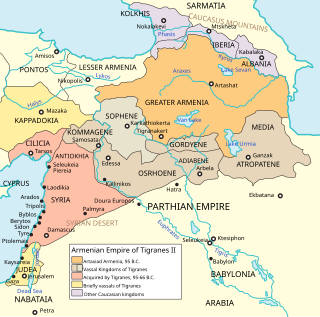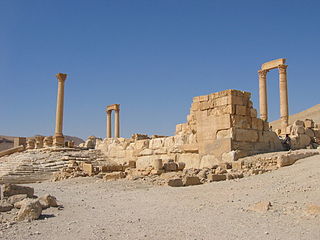Year 176 (CLXXVI) was a leap year starting on Sunday of the Julian calendar. At the time, it was known as the Year of the Consulship of Proculus and Aper. The denomination 176 for this year has been used since the early medieval period, when the Anno Domini calendar era became the prevalent method in Europe for naming years.

Osroene or Osrhoene was an ancient region and state in Upper Mesopotamia. The Kingdom of Osroene, also known as the "Kingdom of Edessa", according to the name of its capital city, existed from the 2nd century BC, up to the 3rd century AD, and was ruled by the Abgarid dynasty. Generally allied with the Parthians, the Kingdom of Osroene enjoyed semi-autonomy to complete independence from the years of 132 BC to AD 214. Though ruled by a dynasty of Arab origin, the kingdom's population was of mixed culture, being Syriac-speaking from the earliest times. The city's cultural setting was fundamentally Syriac, alongside strong Greek and Parthian influences, though some Arab cults were also attested at Edessa.
Gaius Avidius Cassius was a Syrian Roman general and usurper. He was born in Cyrrhus, and was the son of Gaius Avidius Heliodorus, who served as praefectus or governor of Roman Egypt, and Julia Cassia Alexandra, who was related to a number of royal figures, including her descent from both Augustus and Herod the Great. He began his military career under Antoninus Pius, rising to the status of legatus legionis. He served during the Parthian war of Lucius Verus, in which he distinguished himself, for which he was elevated to the Senate, and later made Imperial legate. During the Bucolic War, he was given the extraordinary title of Rector Orientis, giving him Imperium over all of the eastern provinces of the Roman Empire.

Lucius Caecilius Iucundus was a banker who lived in the Roman town of Pompeii around AD 14–62. His house still stands and can be seen in the ruins of the city of Pompeii which remain after being partially destroyed by the eruption of Vesuvius in AD 79. The house is known both for its frescoes and for the trove of wax tablets discovered there in 1875, which gave scholars access to the records of Iucundus' banking operations.

The Panhellenion or Panhellenium was a league of Greek city-states established in the year 131–132 AD by the Roman Emperor Hadrian while he was touring the Roman provinces of Greece.
Gaius Avidius Nigrinus was a Roman senator who lived between the 1st and 2nd centuries. Nigrinus served as suffect consul for the nundinium of April to June 110 with Tiberius Julius Aquila Polemaeanus as his colleague.
Ceionia Plautia was a Roman noblewoman and is among the lesser known members of the ruling Nerva–Antonine dynasty of the Roman Empire.
Plautius Quintillus was a Roman senator who lived in the 2nd century.
Marcus Peducaeus Plautius Quintillus was a Roman noble closely related by birth, adoption, and marriage to the Nerva-Antonine emperors. Through his marriage to Fadilla, the daughter of Emperor Marcus Aurelius and Empress Faustina the Younger, he became the brother-in-law to the future emperor, Commodus. Despite his position, he never became emperor himself. After Commodus was assassinated in 192, he fell out of favor with Septimus Severus during the Year of the Five Emperors. In 205, he killed himself after Septimus issued an order for his execution.
Gaius Claudius Severus was a Roman senator who lived in the second half of the 1st century AD and the first half of the 2nd century AD.
Gnaeus Claudius Severus Arabianus was a senator and philosopher who lived in the Roman Empire.
Gnaeus Claudius Severus was a Roman senator and philosopher who lived in the Roman Empire during the 2nd century AD.

The Strata Diocletiana was a fortified road that ran along the eastern desert border, the limes Arabicus, of the Roman Empire. As its name suggests and as it appears on milestones, it was constructed under Emperor Diocletian as part of a wide-ranging fortification drive in the later Roman Empire. The strata was lined with a series of similarly-built rectangular forts situated at one day's march from each other. It began at the southern bank of the river Euphrates and stretched south and west, passing east of Palmyra and Damascus down to northeast Arabia.

Gaius Julius Sohaemus was a Roman client king of Armenia.
Titus Flavius Claudius Sulpicianus was a Roman statesman who served as Senator and Consul suffectus. He unsuccessfully attempted to succeed his son-in-law Pertinax as Emperor in 193.

Albulae is an ancient city and former bishopric in Roman Africa. It remains a titular see of the Roman Catholic Church. It is identified with the modern town of Ain Temouchent, in present Algeria, near the Moroccan border.
Plautia was a Roman woman of senatorial rank whom Classical scholars believe lived in the late first century and early second century AD. No direct evidence of her existence has yet been found. Ronald Syme comments about her situation, "Plautia exemplifies a common phenomenon in the history of Imperial Rome; a fragment of knowledge rescued from the waters of oblivion, but a figure of consequence in the social and political history of the time."
Publius Tarrutenius Paternus was a Roman eques who flourished during the reign of emperor Marcus Aurelius. He achieved several military successes, leading first to his appointment as praetorian prefect and subsequently to his adlection into the Roman Senate. Paternus was accused of treason by Aurelius' son and successor Commodus, and executed.





